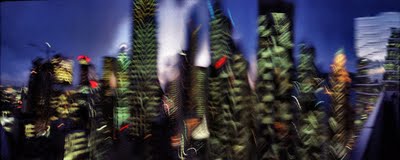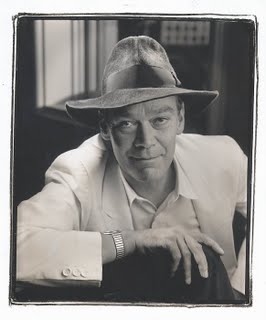Vancouver's Vertical Gated Communities
Saturday, January 30, 2010

There were the Street People and there were the Air People. Air People levitated like fakirs. Large portions of their day were spent waiting for, and travelling in, the elevators that were as fundamental for the middle-class culture of New York as gondolas had been in Venice in the Renaissance. It was the big distinction – to be able to press a button and take wing to your apartment. It didn’t matter that you lived on the sixth, the 16th or 60th floor: access to the elevator was proof that your life had the buoyancy that was needed to stay afloat in a city where the ground was seen as the realm of failure and menace.
In blocks like Alice’s, where the doormen kept up a 24-hour guard against the Street People, the elevator was like the village green. The moment that people were safely inside the cage, they started talking to strangers with cosy expansiveness. As we rattled up through the floors, it was “Hi!”and “Bye!”and “Where did you get that? I just love it” and “Don’t you hate this weather?”…little trills and squawks of sociability that registered everyone’s relief at having escaped the dreadful flintiness of the subway and the street.
Hunting Mister Heartbreak , Jonathan Raban, 1990, Collins Harvil, London

Five years ago I went to Buenos Aires with Rosemary and Rebecca. My nephew Jorge proudly showed me the Catholic barrios cerrados (gated communities always called contrees and pronounced like that!). The idea began some years befored when several families with shared expectations (all white and conservative Roaman Catholic joined forces to buy a large property (in the outskirts) that they would slowly urbanize with electricity, water etc. Walls would be built and houses would follow. My nephew had a contracting company and he made a fortune at this. Soon the gated community would have its little church within its gates. After a few years my nephew had finished quite a few of these. His mother was in charge of landscaping. One of his brothers was helping her with the heavy work of moving and planting trees. Another brother was the firm’s lawyer. Yet another was in charge of publishing a monthly glossy magazine on and about the communities.
The venture became so successful that my nephew travelled to Rome with a well dressed priest (he was Basque and I swear his habit was by Armani) and consulted with a couple of Cardinals who wanted a piece of the pie and so suggested that similar gated communities could be built in the City of Brotherly Love in the United States. I soon found out I could not talk ill of President Bush and gun control in the presence of my pious nephew.
One day having a comfortable lunch in my nephew’s home by an artificial lake he had built within the gated community he lived in, I asked him, “What are you going to do the day, that inevitable day, when the masses climb over your walls?” He beckoned me to follow him into a room. He opened a closet and pulled out a sawed off Argentine Itaka shotgun generally used by the police. From a drawer he removed a Luftwaffe issue Luger pistol and he then said, “I also have a .45 Colt Automatic.” I was speechless but managed to ask, “What are you going to do with these?” “I will target practice.”
The whole affair left me deeply troubled. I have mostly forgotten about it but I sometimes think that my nephew is right when I realize that my two granddaughters are not allowed to either walk to school or to walk back even though they are but a few blocks away. My nephew sends his children to a private Catholic school. They are bussed back and forth. My wife believes that Rebecca and Lauren would be better off in a school like Crofton House or York House. We managed to send our oldest daughter Ale to Yorkhouse beginning in grade 11 when we noticed that her English was spotty and much too slangish. Hilary (our granddaughter’s mother) flatly refused to go to a private school. Now we don’t have the money to help with the granddaughters and their parents would never send them to a private school as they consider them elitist. I am not all that sure as I am the product of private schools.
It was in 2001 that I was taking pictures of artist Alan Storey. I photographed him by his Coopers Mews sculpture. It is a (a whimsical look at what preceded the area(north west side of False Creek) before the condominiums were built. Part of the pathway includes steps that produce steam when one walks on them. He pointed at a nearby baby sitting centre. It seemed odd amidst all the concrete towers.
Storey and I had a fun time during our pleasant shoot. But it was partly jarred by an event that I will not forget. We stopped our picture taking when we saw an extremely beautiful and elegant blue car stop at the gate of one of the condos. It was an Aston Martin being driven by a young man. He glanced in our direction and then the gate went up and he disappeared into his building's garage. We discussed that the kind of luxury that we had previously associated with living in Shaughnessy had a much different counterpart here by his sculpture and that it was a luxury of which we had no inkling. It was a way of life for which we had no understanding.
Today I finally connected the dots in my mind as to what it is that often nags me when I drive my car or take the Number 10 trolley to town and I gaze at Vancouver’s skyline. I went to my library and located Jonathan Raban’s (my snap of him, above right)Hunting Mister Heartbreak (an account of the immigrant Englishman, Raban, travelling around the United States until he settles in Seattle). He begins his story when he arrives by ship to New York (from Southampton, of course!). On page 80 I found what I quote from his book above.
Jonathan Raban’s more exclusive Newyorican Airpeople hardly ever venture from their sky homes. People from the street bring up the food and other required services.
It was from my half-brother’s 18th floor apartment on Avenida Libertador General San Martín, conveniently located near the exclusive shopping centre, Patio Bullrich, that I asked him what were some twinkling lights beyond the tracks of nearby Retiro train Station. “Alejandro,” Enrique explained, “that’s Villa 31 one of the most dangerous villas miseria (shanty towns) in Buenos Aires.” The proximity of Villa 31 to my half-brother’s apartment and my nephew’s comment on the solution to the masses climbing over the fence clicked together today.
Vancouver, as all those head offices, business offices and financial institutions move out of Vancouver, those towers (the Electra Tower and the former Westcoast Energy building are examples) and all the condos that are being built in our city are making it into a vertical gated community. The villas miseria are not yet here. My friend Mark Budgen who lives in Strathcona says that the problems of the Downtown Vancouver East Side will never be solved until the problem is seen as a Canada wide issue. He says that as soon as shelters are built newcomers arrive from Surrey, Alberta, Ontario, Quebec and other parts of Canada. The sprawl of the homeless will continue and soon a few will be recruited to serve those who live up in the towers.
Are we behind New York and Buenos Aires? When will we catch up? Do we want to?






